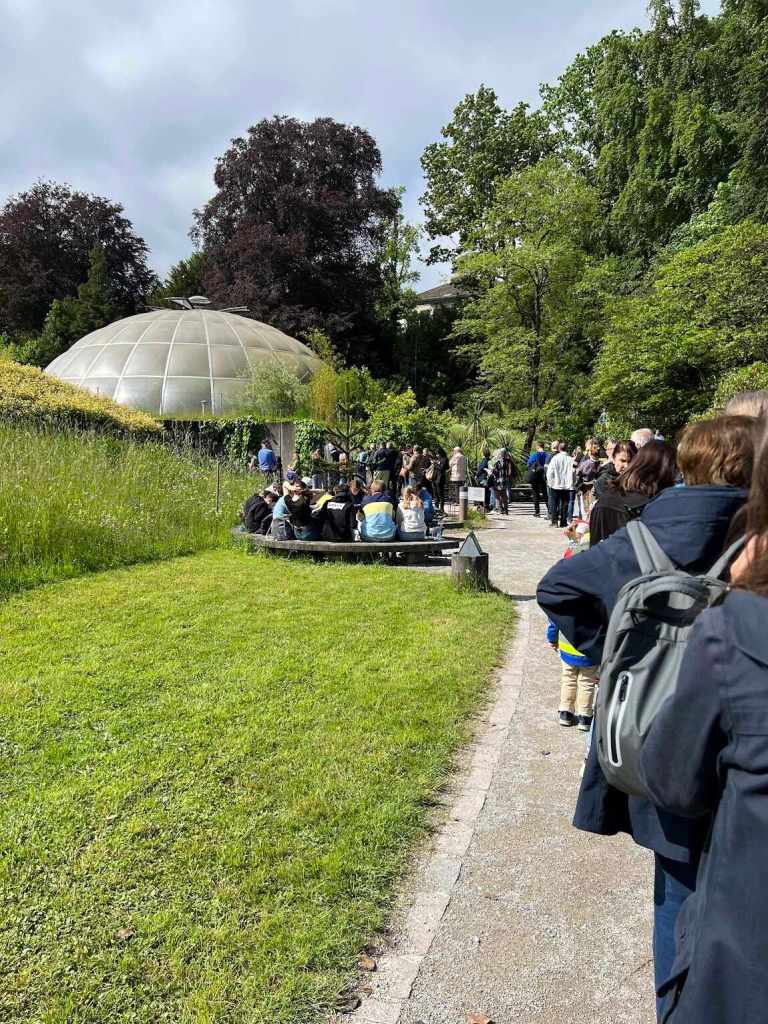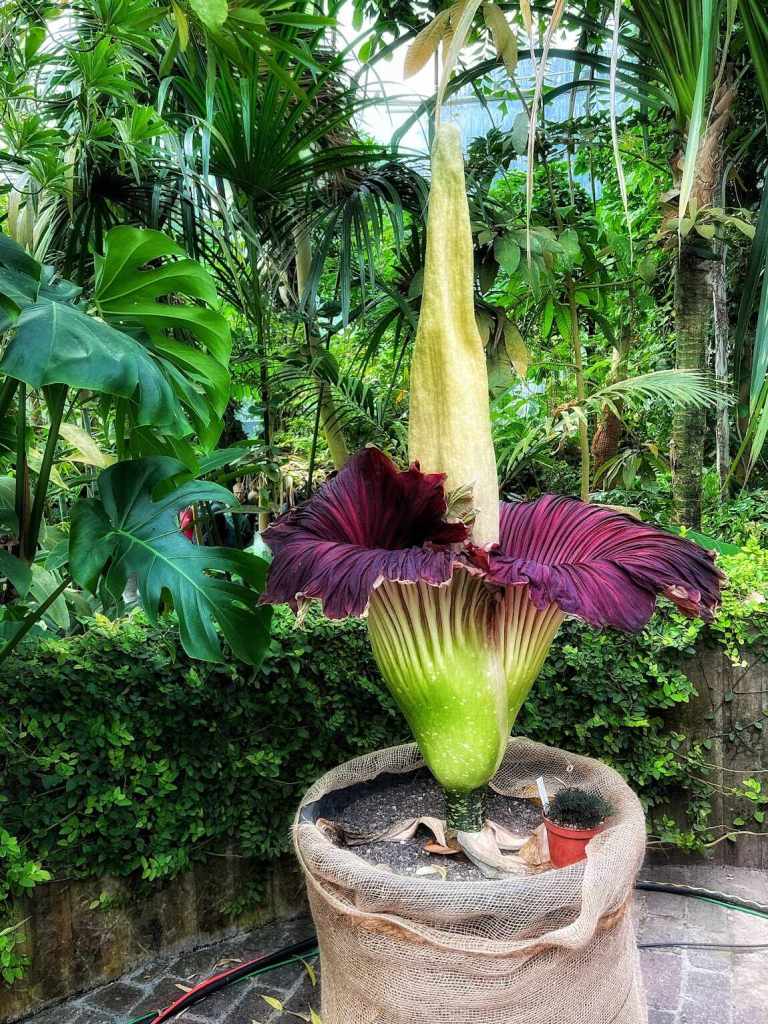I posted photos of this beautiful building here. At the end of the post I said I should come back later for more photos.
Well, I did. Here are two from the main entrance. Rare moments when nobody was walking through.



I posted photos of this beautiful building here. At the end of the post I said I should come back later for more photos.
Well, I did. Here are two from the main entrance. Rare moments when nobody was walking through.


Many Thursday mornings I walk with a group from the American Women’s Club. We enjoy each other’s company as we wander along the lake, the river, or into beautiful gardens. Last Thursday we were treated to a rare occurrence, the blooming of the Amorphophallus titanum. Also known as the Stinky Corpse Flower.
Our walk took us to the Botanical Garden where we waited in this line. I think it took us at least 30 minutes to reach the flower, but it was probably longer. I did not keep track. Too busy socializing.

The Amorphophallus titanum is the largest blooming flower in the world. It has a putrid odor, like rotting flesh. Various sources have it blooming every 2-3 years, or up to every 8 years. I heard that this one last bloomed 4 years ago.

Here’s a close-up.

The line was even longer when we left.
More photos at glampinginswitzerland’s Instagram.
Just down the street from the Villa Patumbah is another free garden to explore. I had been here in 2014, and I’m not sure why I hadn’t been back this time. Spring is definitely a good time to visit the University of Zürich (UZH) Botanical Gardens.
I was there on a sunny day, but the three greenhouses would be a perfect place visit on a cold or rainy day, too.

So many lovely textures.

And patterns.


Even though we were too early for tulips in the Netherlands, I’ve been seeing many around Switzerland.

More photos at glampinginswitzerland’s Instagram.
The University of Zürich has a number of museums which are free. I do not know why it took me so long to visit the Ethnographic Museum. A friend invited me on a cold day last week.
This museum of artifacts from non-European cultures is in the Old Botanical Garden.

Last week there were three exhibits open. The first we visited showcased the amazing and intricate needlework of the Miao Women of Southwest China. These photos do not do the craftsmanship justice.

Another room displayed artifacts from Columbia.

The last exhibit we saw was called Honeymoon?, although it was not what we had imagined. These are East African artifacts collected by Helen and Hans Paasche on their honeymoon in 1909. The exhibit asks visitors to ponder the questions of context, provenance, skill, contemporary, and reconnection.
Today, the origin of the objects and their significance for the descendants of the people who created them are the focus of research at the Ethnological Museum of the University of Zurich. The exhibition «Honeymoon?» makes the process of this research transparent – and shows the associated challenges. Five central questions on the keywords “context”, “provenance”, “skill”, “contemporary” and “reconnection” run through the exhibition both conceptually and spatially. A world map traces the journey of the objects from Tanzania and Rwanda to Zurich. Biographical information and reading stations with publications and letters present the Paasche couple.

Certainly the study of anthropology has been changing recently.
Since our visit, a new exhibition has opened. It’s called Looted Cultural Property from China’s Imperial Era.
More photos at glaminginswitzerland’s Instagram.
Another great place for city views on the cheap (meaning free) in addition to the top of the Freitag tower, is the terrace at the ETH known as the Polyterrasse. This large area in front of the main building of the ETH claims to have 30,000 pedestrians cross it every day. It is rather like the front porch of a very important mansion overlooking the land.
A few weeks ago, these were the sunset views from this vantage point.


I cannot count the number of times I have passed this sculpture on the way to and from our apartment, but it’s in the hundreds, as the trams go by it.

From our apartment we have a partial view of this building. We thought it might be a sports hall, and we did not know it was part of the building with the above sculpture.

Turns out it is the University of Zürich Law Library. It was built in 1909 as the chemistry building. In 2004, it opened up after a complete renovation by Spanish architect Santiago Calatrava. He left the outside of the building intact and integrated the new section in the courtyard.
Visitors may enter the library during opening hours, and photography on the first floor is allowed.

This website says, “The university library is roofed with a glass cupola featuring an integrated mechanical solar shade, which maximizes daylight in winter and minimizes immoderate heat in summer. 5000 meters space for books and 500 working places are offered.”
One clue that our German has improved in the past eight years is that this time we are ready to read books in German. We decided to get a public library card, so we headed over to the Zentralbibliothek Zürich.
(Side Note: It has occurred to me, after many blog posts, that it may not be clear that I include embedded links. If you click on the light blue words above, it will take you to an additional site with. more information.)
This library is a joint venture between the University of Zürich and the city. Anyone can get a card, and you can apply online. The building is in the Predigerkloster (the former Black Friar’s Abbey next to the Predigerkirche. The photo on the left is the old part of the building. The one on the right, the new addition.

I have been meaning to read the book Tschick by Wolfgang Hernndorf which has come highly recommended. After figuring out the website, we discovered the location of the book.
I had been warned that the German (and apparently Swiss) way of cataloging books is in no way uniform across libraries. Each book is given a number in the order it was acquired by the library. No Library of Congress, no Dewey Decimal. Correct me if I’m wrong. I found that the number of the book was HM 60542.
First I went down the stairs. All the rooms on the main floor and above are for studying, and it seemed that most chairs were filled. The books are in various levels of the basement.

I found the HM section with the correct numbers. I rolled one set of shelves aside, and found the right number. It’s the green book on the left. It only lists the author’s last name, so I had to pull it out to make sure it was the right book.

For fun, I looked to see if Tschick was at another library and what its number might be. Sure enough, it appears in the Basel Pädigogisches Zentrum with the call number PZB_GB_3004 HERR 3.
I wonder how people browse in these libraries. I would assume that one author’s books would be scattered throughout the collection, and non-fiction books are not grouped by category. I would be very interested in insights. If you have any, please leave them in the comments below.
There are pictures of the lovely staircases on glampinginswitzerland’s Instagram. (see, that’s a link here!)
On Sunday I felt a little better, so I took a short walk to this nearby overlook. You can see that autumn has arrived. The hill in the photo is Uetliberg. It was one of the first places we went in 2014. The green-domed building is the main building of the University of Zurich.

I have been inside the main building at the UZH (University of Zurich) a few times. I was not sure where to find the Little Free Library, so I asked a student who was handing out flyers at the entrance where it might be. He had no idea, but he sent me downstairs. I walked downstairs, upstairs, looked at maps, and then I decided to just take photos. It is a grand building.



I may have to go back to take more photos, but for now here are these three and a few more on glampinginswitzerland’s Instagram.
In the meantime, just ask at the Information Desk in the front if you want to find some place in the building….
Along with the Botanical Gardens (Old and New), the Paleontology, Ethnographic, and Zoological Museums (among others), the University of Zürich also houses an Archeological Museum. Only 10 minutes down the hill by foot from our flat.
 The ground floor displays a variety of pots and some sculptures from Ancient Greece and Rome, the Etruscans, and Ancient Egypt. None of the signs are in English, and most of the vocabulary is mysterious to me, so I just made up little stories about the pieces and enjoyed the interesting figures on the pots. Some of the pieces had no signage at all.
The ground floor displays a variety of pots and some sculptures from Ancient Greece and Rome, the Etruscans, and Ancient Egypt. None of the signs are in English, and most of the vocabulary is mysterious to me, so I just made up little stories about the pieces and enjoyed the interesting figures on the pots. Some of the pieces had no signage at all.
No photos are allowed, so you have to look at their website to get an idea of what it looks like.
The real treat came downstairs, though. Apparently the collection started in the 19th C. with plaster casts of antique sculptures. I really, really wanted to take a picture here, but I was so good in restraining myself. I did find this photo online of what looks like a wall in your local garden store that sells garden statues.
 These are just the busts. Along the outer walls, and in the rooms on either end of the long hall are some very, very tall statues – 2-3 times larger than actual humans. One reminded us of a very large bust of the Statue of Liberty.
These are just the busts. Along the outer walls, and in the rooms on either end of the long hall are some very, very tall statues – 2-3 times larger than actual humans. One reminded us of a very large bust of the Statue of Liberty.
We were alone down there, which was just a little creepy. Creepy in a fun way. As we walked, automatic lights came on. And then we found out that we were NOT alone. Hidden in a back corner was a woman who, I think, was sketching.
H could not resist taking a photo of this guy – Plato. It reminded us very much of someone we know back home. Our friend’s beard is a little shorter, though.